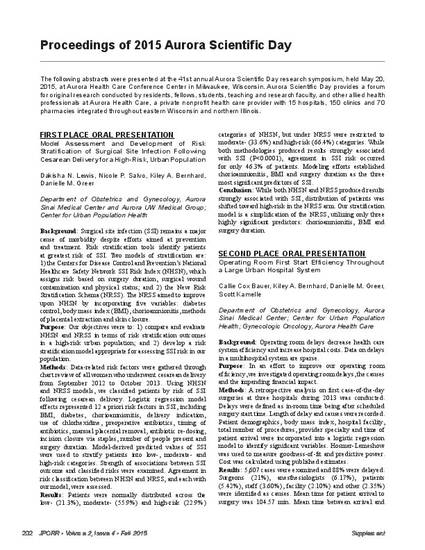
- surgical site infection,
- cesarean delivery,
- high-risk population
Background: Surgical site infection (SSI) remains a major cause of morbidity despite efforts aimed at prevention and treatment. Risk stratification tools identify patients at greatest risk of SSI. Two models of stratification are: 1) the Centers for Disease Control and Prevention’s National Healthcare Safety Network SSI Risk Index (NHSN), which assigns risk based on surgery duration, surgical wound contamination and physical status; and 2) the New Risk Stratification Schema (NRSS). The NRSS aimed to improve upon NHSN by incorporating five variables: diabetes control, body mass index (BMI), chorioamnionitis, methods of placental extraction and skin closure.
Purpose: Our objectives were to: 1) compare and evaluate NHSN and NRSS in terms of risk stratification outcomes in a high-risk urban population; and 2) develop a risk stratification model appropriate for assessing SSI risk in our population.
Methods: Data-related risk factors were gathered through chart review of all women who underwent cesarean delivery from September 2012 to October 2013. Using NHSN and NRSS models, we classified patients by risk of SSI following cesarean delivery. Logistic regression model effects represented 12 a priori risk factors in SSI, including BMI, diabetes, chorioamnionitis, delivery indication, use of chlorhexidine, preoperative antibiotics, timing of antibiotics, manual placental removal, antibiotic re-dosing, incision closure via staples, number of people present and surgery duration. Model-derived predicted values of SSI were used to stratify patients into low-, moderate- and high-risk categories. Strength of associations between SSI outcome and classified risks were examined. Agreement in risk classification between NHSN and NRSS, and each with our model, were assessed.
Results: Patients were normally distributed across the low- (21.3%), moderate- (55.9%) and high-risk (22.9%) categories of NHSN, but under NRSS were restricted to moderate- (33.6%) and high-risk (66.4%) categories. While both methodologies produced results strongly associated with SSI (P < 0.0001), agreement in SSI risk occurred for only 46.3% of patients. Modeling efforts established chorioamnionitis, BMI and surgery duration as the three most significant predictors of SSI.
Conclusion: While both NHSN and NRSS produced results strongly associated with SSI, distribution of patients was shifted toward high-risk in the NRSS arm. Our stratification model is a simplification of the NRSS, utilizing only three highly significant predictors: chorioamnionitis, BMI and surgery duration.
